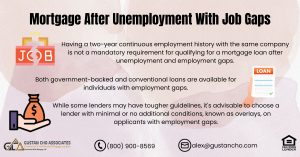In this blog, we will cover and discuss refinancing with judgment mortgage lending guidelines. Mortgage rates are still low and many homeowners have not refinanced their higher interest mortgage home loans yet. A full rate and term and/or cash-out refinance mortgage process is the same as applying for a home purchase mortgage loan.
However, FHA and VA loans have a fast-track streamline refinance loan program with no income docs, and no appraisal requirements. In the following paragraphs, we will discuss refinancing with judgment and what hurdles homeowners can run into.
What is the Rule of Thumb for Refinancing?
Deciding to refinance your mortgage is a substantial financial choice that requires thoughtful contemplation. Firstly, it’s essential to factor in the length of time you intend to stay in your current property. If you plan to remain for several years, the savings from a lower interest rate could offset the costs associated with refinancing, such as closing fees.
Additionally, assessing your current financial situation is crucial. If you have experienced an improvement in your credit score or if market conditions have become favorable, refinancing may be an option worth considering. This could allow you to qualify for more advantageous terms and conditions, making it a viable solution. It is possible to qualify for refinancing with more favorable terms if there has been an improvement in your credit score or if market conditions have changed.
The “2% rule” serves as a helpful guideline, indicating that it’s typically worthwhile to refinance if you can lower your interest rate by at least 2%. However, this rule isn’t a one-size-fits-all solution and should be weighed alongside other critical factors.
Moreover, consider your long-term financial goals when contemplating a refinance. If you’re considering refinancing, talking to a financial advisor or mortgage specialist can be helpful. They can help you understand the process and determine if it fits your overall financial plan well.
While reducing your monthly payments can provide immediate relief, it’s important to consider switching to a shorter loan term or converting from an adjustable-rate to a fixed-rate mortgage for greater financial security and savings in the long run. It is important to ensure that you obtain expert advice to help you make an educated choice that aligns with your financial objectives.
Speak With Our Loan Officer for Mortgage Loans
What are the Steps of Refinancing?
Refinancing your mortgage involves several steps to ensure a smooth transition to a new loan with more favorable terms. Below is a general sketch of the usual stages involved in refinancing:
- Evaluate Your Finances: Evaluate your present financial position, which includes your credit rating, earnings, and unpaid debts. Determine your refinancing goals, whether it’s to lower your monthly payments, reduce the loan term, or access equity.
- Shop Around for Rates: To ensure the best interest rates and loan terms, comparing loan offers from multiple lenders is important. Evaluating lenders based on factors such as closing costs, loan terms, and customer service reputation is advisable to make a well-informed decision.
- Submit a Refinance Application: Once you’ve selected a lender, complete a refinance application. To proceed, you must furnish documentation such as pay stubs, bank statements, tax returns, and details regarding your present mortgage.
- Undergo a Home Appraisal: The lender typically requires a home appraisal to assess the property’s current value. This helps determine the loan-to-value ratio (LTV) and ensures that the property is adequate collateral for the new loan.
- Review and Sign Loan Documents: After your loan application gets approved, you will receive loan terms and closing disclosures from the lender. Before finalizing the refinance, it is crucial to review all documents carefully.
- Pay Closing Costs: Similar to when you initially purchased the property, refinancing typically involves closing costs, including fees for appraisal, title search, origination, and other administrative expenses. Be prepared to pay these costs upfront or roll into the new loan.
- Wait for Loan Funding: After signing the loan documents, the lender will fund the new loan, paying off your existing mortgage. Depending on the lender’s processing time, this process can take several days to a few weeks.
- Begin Making Payments on the New Loan: Once the refinance is complete, you’ll start making monthly payments on the new loan according to the terms outlined in the loan agreement.
It is crucial to remain informed throughout the refinancing process and maintain regular communication with your lender. Furthermore, seeking guidance from a financial advisor or mortgage specialist can offer valuable insight to help you navigate the complexities of refinancing and make informed decisions.
Benefits of Refinancing to a Lower Mortgage Rate
By refinancing a high-interest rate mortgage to a lower rate mortgage can save homeowners tens of thousands of dollars over the life of the mortgage loan term. Monthly payments can greatly be reduced by refinancing a home. Lenders will need to see income, credit, and liabilities. Having a period of prior bad credit is fine and understandable.
Collection accounts with balances do not have to be paid, depending on the mortgage lender. However, refinancing with judgment or judgments is a different story. Is it possible for homeowners to refinance with judgment? The answer is yes but under certain circumstances. Refinancing with judgment is possible and we will discuss ways of refinancing with judgment.
What are the Primary Considerations that Should be Made When Refinancing?
What is a Judgment, and How is Refinancing with Judgment Possible

A judgment is when a judge rules in favor of the creditor plaintiff on a monetary sum owed by a debtor. Consumers must properly be served for the judgment to be valid. The creditor will file a lawsuit with the county courthouse. The county sheriff or process server needs to serve the consumer with a summons to appear in court.
If the defendant does not show up, the judge normally issues a judgment in favor of the creditor. Defendants can show up with proof that the debt has been settled or does not belong to them. If the judge deems it that the creditor does not have a valid reason to warrant the collection, the judge will dismiss the lawsuit and everything is expunged.
However, most consumers who do owe debt normally do not show up in court. Missing the court date, the judge will rule in favor of the plaintiff.
How Does Refinancing Work Debt?
Refinancing replaces your current debt with a new loan offering better terms. Here’s a simplified process:
- Apply for a new loan with a lender.
- Undergo credit evaluation and, for mortgages, property appraisal.
- Review and accept loan terms.
- Complete the closing process, paying any associated fees.
- Use the new loan to pay off your existing debt.
- Begin making payments on the new loan.
By refinancing, you aim to lower monthly payments, reduce interest costs, or adjust loan terms to better fit your financial goals.
Judgments Are Worst Derogatory
A judgment is probably the worst derogatory item a consumer can have against on credit report. A judgment remains on credit report for 7 years from the date it was entered. But most judgments have a statute of limitations for 10 years, depending on the state.
Judgment creditors can renew the judgment once the statute of limitations expires in ten years for another ten years. Good news is that most judgment creditors do not renew dormant judgments.
Creditor Enforcement Of Judgment
Suppose a creditor has a judgment against a defendant. In that case, the creditor can enforce the judgment by trying to place liens on assets such as home, other properties, bank accounts, investment account. Or they can even try to garnish wages. However, those who do not have many assets or no assets, and no income are considered judgment proof.
Judgment Proof means they cannot do anything because debtors do not own anything of value. Once a judgment creditor has a judgment against, they can try to collect on the judgment aggressively. When they find out that the debtor does not have much assets or income, they will eventually lay off. As the judgment ages, the collection activity will die down. The judgment will eventually become dormant.
However, if the judgment creditor gets wind that debtor has assets or are making a good income, they can restart and aggressively pursue collection proceedings. Most judgment creditors do not renew the judgments after the statute of limitations period is over.
How Can I Vacate A Judgment?
There are three ways of getting rid of judgment.
- The first and easiest guaranteed way of getting rid of a judgment is by filing Chapter 7 bankruptcy
- Most judgments are discharged on a bankruptcy unless the judgment is from fraud or a government debt such as a tax lien or delinquent student loans
- Child support and alimony debts cannot be discharged through bankruptcy
- The second way of getting rid of a judgment is by paying off the judgment or entering into a written payment agreement with the judgment creditor
- Debtors can settle for a percentage on the judgment amount owed and have the judgment creditor clear of the judgment and record it on public records as satisfied
The third way of getting rid of a judgment is by having it vacated by petitioning the courts that they were not served properly.
Homeowners Refinancing With Judgment
For homeowners who have a money judgment against them, the judgment creditor can have an interest and lien against their property. Money judgments are court rulings where the courts issue an interest against the property owned by the judgment debtor. Mortgage lenders do not want to lend on any property that has a judgment against it.
Many lenders will require that the judgment be paid off and released in order to proceed with refinancing with judgment. Other lenders will entertain refinancing with judgment as long as the judgment debtor has a written payment agreement with the judgment creditor and has made three timely payments. Canceled checks and/or bank statements need to be provided. Get approval for Mortgage Loans, Click here
Starting Refinancing With Judgment Mortgage Process
Refinancing with judgment is possible. However, borrowers need to discuss the judgment issue before proceeding with the processing and underwriting of refinance mortgage loans.
Worst case scenario, borrower may need to enter into a written payment plan with the judgment creditor and make three payments to them for them to be able to proceed with refinancing. Gustan Cho Associates will allow judgments to be paid at closing with excess funds from a cash-out refinance mortgage.
Collection Accounts Can Become Judgments
Another fearsome mortgage lenders have is that an unsatisfied collection account can be a time bomb in turning into judgments. Although under FHA guidelines, a mortgage loan applicant can qualify for a mortgage loan with unsatisfied collection accounts with credit balances, many lenders have overlays that unpaid collection accounts need to be paid in full for a mortgage loan application to proceed.
The reason lenders have overlays on having collection accounts paid in full is due to fear of having collection accounts become judgments.
Refinancing With Judgment With Lender With No Overlays
Homeowners refinancing with judgment do not have to pay off the outstanding judgment prior to closing. If the borrower is doing a cash-out refinance mortgage and gets proceeds that will cover the outstanding judgment, the judgment can be paid at closing.
Borrowers needing to qualify for a mortgage with a direct lender with no mortgage overlays can contact us at Gustan Cho Associates at 800-900-8569 or text us for a faster response. Or email us at gcho@gustancho.com. Gustan Cho Associates Mortgage Group has no overlays on FHA, VA, USDA, and Conventional Loans. We allow judgments to be paid at closing on cash-out refinance mortgage borrowers.
FAQs about Refinancing With Judgment Mortgage Lending Guidelines
1. What is a rule of thumb for Refinancing? The rule of thumb is to consider Refinancing if you can lower your interest rate by at least 2%. However, various factors should be weighed, including your financial situation, goals, and market conditions.
2. What are the Steps of Refinancing? The steps involve:
- Evaluating finances.
- Shopping for rates.
- Applying.
- Undergoing an appraisal (for mortgages).
- Reviewing and signing loan documents.
- Paying closing costs.
- Waiting for loan funding.
- Starting payments on the new loan.
3. What are the Primary Considerations for Refinancing? When refinance, consider interest rates, loan terms, closing costs, equity, credit score, financial goals, prepayment penalties, and market conditions.
4. How Does Refinancing Work with Judgment? Refinancing involves replacing your current debt with a new loan offering better terms. While judgment can complicate refinancing, options exist, such as paying off the judgment or entering into a payment agreement with the creditor.
5. Can I Vacate a Judgment? Judgments can be vacated through bankruptcy, payment, or petitioning the courts for improper service. Bankruptcy or settling with the creditor are common methods, while vacating based on improper service may require legal action.
6. Can I Refinance with a Judgment? Refinancing with a judgment is possible, but lenders may require paying off the judgment or having a payment agreement with the creditor. Some lenders may have overlays, while others, like Gustan Cho Associates, allow judgments to be paid at closing on cash-out refinance mortgages.
This blog about Refinancing With Judgment Mortgage Lending Guidelines was updated on March 15, 2024. Speak With Our Loan Officer for Mortgage Loans









do you do reverse mortgages
Yes. We do reverse mortgages. Can you please email us your contact information at gcho@gustancho.com or call us at 262-716-8151. Text us for a faster response.